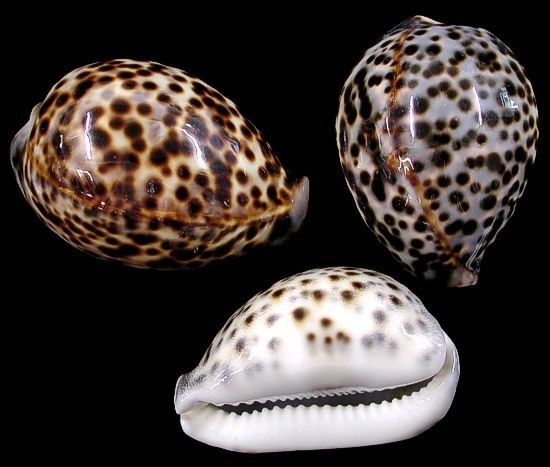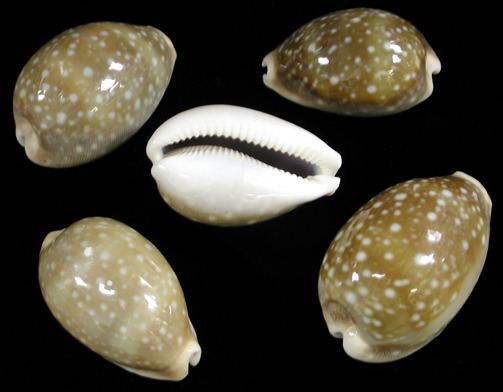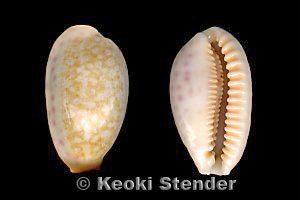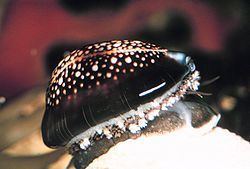Kingdom Animalia Class Gastropoda Order Littorinimorpha | Phylum Mollusca Subclass Caenogastropoda Superfamily Cypraeoidea | |
 | ||
Representative species Trivia monacha, Calpurnus verrucosus, Monetaria moneta, Jenneria pustulata, Trivia arctica | ||
Cowry shell island alan stokes in the maldives animal
Cowry or cowrie, plural cowries, is the common name for a group of small to large sea snails, marine gastropod molluscs in the family Cypraeidae, the cowries. The word cowry is also often used to refer only to the shells of these snails, which overall are often shaped more or less like an egg, except that they are rather flat on the underside.
Contents
- Cowry shell island alan stokes in the maldives animal
- Cowry shell oahu north shore
- Shell description
- Etymology
- Human use
- References

Many people throughout history have found (and still find) the very rounded, shiny, porcelain-like shells of cowries pleasing to look at and to handle. Indeed, the term "porcelain" derives from the old Italian term for the cowrie shell (porcellana) due to their similar translucent appearance. Shells of certain species have historically been used as currency in several parts of the world, as well as being used, in the past and present, very extensively in jewellery, and for other decorative and ceremonial purposes.

The cowry was the shell most widely used worldwide as shell money. It is most abundant in the Indian Ocean, and was collected in the Maldive Islands, in Sri Lanka, along the Malabar coast, in Borneo and on other East Indian islands, and in various parts of the African coast from Ras Hafun to Mozambique. Cowry shell money was important at one time or another in the trade networks of Africa, South Asia, and East Asia.

Some species in the family Ovulidae are also often referred to as cowries. In the British Isles the local Trivia species (family Triviidae, species Trivia monacha and Trivia arctica) are sometimes called cowries. The Ovulidae and the Triviidae are somewhat closely related to Cypraeidae.

Cowry shell oahu north shore
Shell description
The shells of cowries are usually smooth and shiny and more or less egg-shaped, with a flat under surface which shows a long, narrow, slit-like opening (aperture), which is often toothed at the edges. The narrower end of the egg-shaped cowry shell is the anterior end. The spire of the shell is not visible in the adult shell of most species, but is visible in juveniles, which have a different shape from the adults.
Nearly all cowries have a porcelain-like shine, with some exceptions such as Hawaii's granulated cowry, Nucleolaria granulata. Many have colorful patterns. Lengths range from 5 mm for some species up to 19 cm for the Atlantic deer cowry, Macrocypraea cervus.
Etymology
The word cowrie comes from Hindi कौड़ी (kaurī) and ultimately from Sanskrit कपर्द (kaparda).
Human use
Cowry shells, especially Monetaria moneta, were used for centuries as currency in Africa. After the 1500s, however, it became even more common. Western nations, chiefly through the slave trade, introduced huge amounts of Maldivian cowries in Africa. The Ghanaian unit of currency known as the Ghanaian cedi was named after cowry shells. Starting over three thousand years ago, cowry shells, or copies of the shells, were used as Chinese currency. They were also used as means of exchange in India.
The Classical Chinese character for money (貝) originated as a stylized drawing of a Maldivian cowrie shell. Words and characters concerning money, property or wealth usually have this as a radical. Before the Spring and Autumn period the cowrie was used as a type of trade token awarding access to a feudal lord's resources to a worthy vassal.
The Ojibway aboriginal people in North America use cowry shells which are called sacred Miigis Shells or whiteshells in Midewiwin ceremonies, and the Whiteshell Provincial Park in Manitoba, Canada is named after this type of shell. There is some debate about how the Ojibway traded for or found these shells, so far inland and so far north, very distant from the natural habitat. Oral stories and birch bark scrolls seem to indicate that the shells were found in the ground, or washed up on the shores of lakes or rivers. Finding the cowry shells so far inland could indicate the previous use of them by an earlier tribe or group in the area, who may have obtained them through an extensive trade network in the ancient past. Petroforms in the Whiteshell Provincial Park may be as old as 8,000 years.
Cowry shells are also worn as jewelry or otherwise used as ornaments or charms. They are viewed as symbols of womanhood, fertility, birth and wealth. The symbolism of the cowry shell is associated with the appearance of its underside: the lengthwise opening makes the shell look like a vulva or an eye.
Cowry shells are sometimes used in a way similar to dice, e.g., in board games like Pachisi, Ashta Chamma or in divination (cf. Ifá and the annual customs of Dahomey of Benin). A number of shells (6 or 7 in Pachisi) are thrown, with those landing aperture upwards indicating the actual number rolled.
In Nepal cowries are used for a gambling game, where 16 pieces of cowries are tossed by four different bettors (and sub-bettors under them). This game is usually played at homes and in public during the Hindu festival of Tihar or Deepawali. In the same festival these shells are also worshiped as a symbol of Goddess Laxmi and wealth.
Cowry shells were among the devices used for divination by the Kaniyar Panicker astrologers of Kerala, India.
On the Fiji Islands, a shell of the golden cowry or bulikula, Cypraea aurantium, was drilled at the ends and worn on a string around the neck by chieftains as a badge of rank. The women of Tuvalu use cowrie and other shells in traditional handicrafts.
Large cowry shells such as that of a Cypraea tigris have been used in Europe in the recent past as a darning egg over which sock heels were stretched. The cowry's smooth surface allows the needle to be positioned under the cloth more easily.
